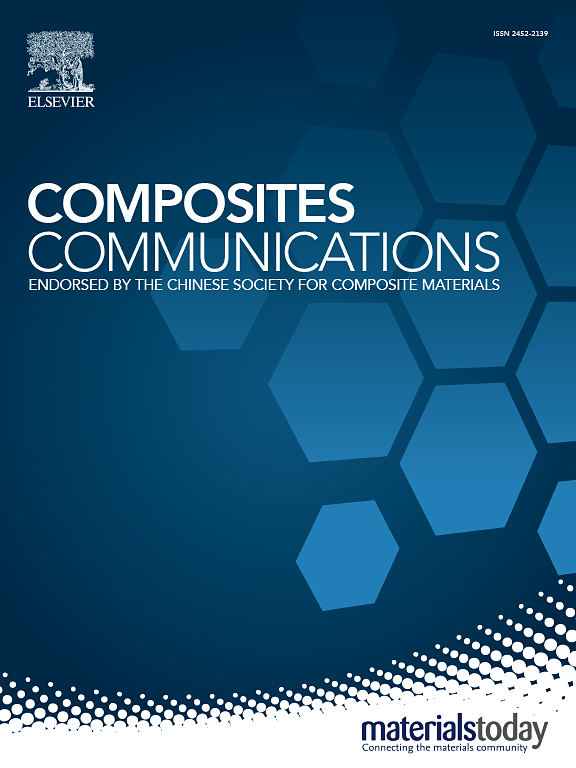高强度、自愈合水性聚氨酯弹性体,具有更强的机械、热和电气性能
IF 7.7
2区 材料科学
Q1 MATERIALS SCIENCE, COMPOSITES
引用次数: 0
摘要
长期以来,开发既具有高强度又具有出色自愈合效率的弹性体一直是一项挑战,因为提高强度通常会影响断裂伸长率和自愈合能力。在这项工作中,我们通过引入二硫键作为动态键,平衡了水性聚氨酯(WPU-SS)弹性体的机械强度和自愈合效率。二硫键在外力作用下断裂并重组,从而诱导聚氨酯体系中的微相分离,增强拉伸强度和韧性,并促进分子链流动以提高自愈合效率。氢键含量的增加进一步提高了自愈合效率和机械强度。因此,在温和加热条件下,WPU-SS 弹性体的最大断裂强度达到 26.6 兆帕,断裂伸长率为 664.6%,自愈合效率为 83.4%。通过用多巴胺改性液态金属(LM)并将其与 WPU-SS 复合,得到了 WPU-SS/LM 复合材料。当 LM 的体积含量为 15%时,复合材料的机械性能和韧性得到了最显著的改善,断裂强度达到 43 兆帕,是 WPU-SS 的 160 倍。WPU-SS/LM 的导热系数随 LM 含量的增加而成正比增加,当 LM 含量为 25% 时,导热系数达到 WPU-SS 的 583.7%。此外,当 LM 含量为 10% 时,WPU-SS/LM 可以通过物理烧结达到永久导电性。WPU-SS/LM 复合材料的机械、热和电性能都得到了增强,因此有望应用于导电弹性体和动态开关中。本文章由计算机程序翻译,如有差异,请以英文原文为准。

High-strength, self-healing waterborne polyurethane elastomers with enhanced mechanical, thermal, and electrical properties
Developing elastomers that exhibit both high strength and excellent self-healing efficiency has been a longstanding challenge, as enhancing strength typically compromises fracture elongation and self-healing capabilities. In this work, we balance the mechanical strength and self-healing efficiency of waterborne polyurethane (WPU-SS) elastomers by introducing disulfide bonds as dynamic bonds. Disulfide bonds break and reorganize under external forces, inducing microphase separation in the polyurethane system, enhancing tensile strength and toughness, and promoting molecular chain flow to improve self-healing efficiency. The increased hydrogen bonding content further boosts both self-healing efficiency and mechanical strength. As a result, the maximum fracture strength of the WPU-SS elastomer achieves 26.6 MPa with an elongation at break of 664.6 %.and a self-healing efficiency of 83.4 % under mild heating conditions. By modifying liquid metal (LM) with dopamine and compounding it with WPU-SS, WPU-SS/LM composites are obtained. When the volume content of LM was 15 %, the composite exhibits the most significant improvements in mechanical properties and toughness, with a fracture strength of 43 MPa, which is 160 % times of that of WPU-SS. The thermal conductivity of WPU-SS/LM increases proportionally with the LM content, reaching 583.7 % of that of WPU-SS at 25 % LM content. Further, at 10 % LM content, WPU-SS/LM could be physically sintered to achieve permanent electrical conductivity. This enhanced mechanical, thermal, and electrical performance makes WPU-SS/LM composites promising for applications in conductive elastomers and dynamic switches.
求助全文
通过发布文献求助,成功后即可免费获取论文全文。
去求助
来源期刊

Composites Communications
Materials Science-Ceramics and Composites
CiteScore
12.10
自引率
10.00%
发文量
340
审稿时长
36 days
期刊介绍:
Composites Communications (Compos. Commun.) is a peer-reviewed journal publishing short communications and letters on the latest advances in composites science and technology. With a rapid review and publication process, its goal is to disseminate new knowledge promptly within the composites community. The journal welcomes manuscripts presenting creative concepts and new findings in design, state-of-the-art approaches in processing, synthesis, characterization, and mechanics modeling. In addition to traditional fiber-/particulate-reinforced engineering composites, it encourages submissions on composites with exceptional physical, mechanical, and fracture properties, as well as those with unique functions and significant application potential. This includes biomimetic and bio-inspired composites for biomedical applications, functional nano-composites for thermal management and energy applications, and composites designed for extreme service environments.
 求助内容:
求助内容: 应助结果提醒方式:
应助结果提醒方式:


